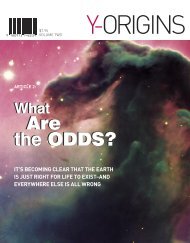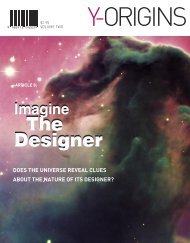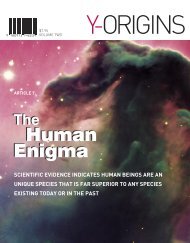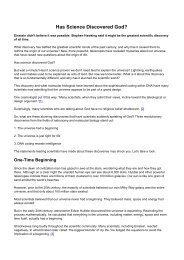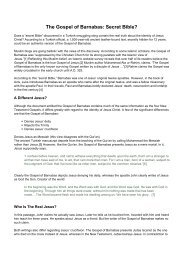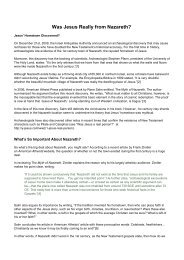missing_link6
Create successful ePaper yourself
Turn your PDF publications into a flip-book with our unique Google optimized e-Paper software.
GRADUATING FROM<br />
GRADUALISM<br />
Eldredge discloses that the Darwinian<br />
paradigm is so strong that paleontologists<br />
refused to admit defeat by acknowledging<br />
gradualism as wrong. “Paleontologists<br />
clung to the myth of gradual adaptive<br />
transformation even in the face of plain<br />
evidence to the contrary… ” 19<br />
Eldredge and his colleague Gould, however,<br />
responded to the lack of transitional fossils<br />
by developing a new theory called punctuated<br />
equilibria, a complete departure from<br />
Darwin’s basic premise of gradualism. 20<br />
The punctuated equilibria theory contends<br />
that evolution, rather than being a gradual<br />
process, flourished quickly in small, isolated<br />
geographic regions, and then stabilized.<br />
But evolution was the exception, and rarely<br />
occurred.<br />
Gould and Eldredge have argued that a<br />
sudden jump from species to species is the<br />
only way to explain the <strong>missing</strong> transitional<br />
fossils. Denton contests their conclusions<br />
are difficult to believe. “To suggest that …<br />
possibly even millions of transitional species<br />
… were all unsuccessful species occupying<br />
isolated areas and having very small population<br />
numbers is verging on the incredible.” 21<br />
Whereas Darwin’s theory required many millions<br />
of years, punctuated equilibria speculates<br />
that body forms evolved in hundreds<br />
of thousands of years, merely 100 th of one<br />
percent of Earth’s history. There is no known<br />
mechanism that can work so fast.<br />
Based upon the fossil evidence, the following<br />
conclusions can be drawn:<br />
1. Cambrian fossils contradict<br />
Darwin’s theory.<br />
2. Transitional fossils have failed to<br />
show up.<br />
3. Most species don’t change.<br />
4. Perplexed materialists are seeking<br />
non-Darwinian explanations.<br />
Gerald Schroeder cites how microevolutionary<br />
examples are used by Darwinists as<br />
“proof” of macroevolution: “…when the London<br />
Museum of natural History, a bastion<br />
of Darwinian dogma, mounted a massive<br />
exhibit on evolution, occupying an entire<br />
wing of the second floor, the only examples<br />
it could show were pink daisies evolving<br />
into blue daisies, little dogs evolving into<br />
big dogs, a few dozen species of cichlid fish<br />
evolving into hundreds of species of---you<br />
guessed it---cichlid fish. They could not<br />
come up with a single major morphological<br />
change clearly recorded in the fossil record.<br />
I am not anti-evolution. And I am not procreation.<br />
What I am is pro-look-at-the-dataand-see-what-they-teach.”<br />
22<br />
EVOLUTION<br />
WITH A PURPOSE?<br />
Some scientists believe that the chemistry<br />
of life has been fine-tuned and that evolution<br />
was programmed into nature’s laws.<br />
Conway Morris of Cambridge University,<br />
acknowledged as one of the foremost<br />
paleontologists of his time, has proposed a<br />
theory that combines design and evolution.<br />
Morris observes, “Far from being a random,<br />
directionless process, evolution shows deep<br />
patterns, and perhaps even a purpose.” 23<br />
In his book Life’s Solution, Morris makes a<br />
compelling case for inherent design in life.<br />
THE CASE OF THE MISSING LINK • ARTICLE 6 • 11




